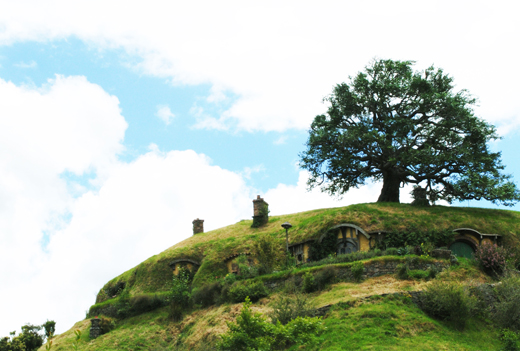
Millions line up at Universal Studios in L.A. for a chance to pull back the curtain and see behind the illusions of Hollywood films and television. At the Hobbiton movie set in Matamata, tourists pour into the area for exactly the opposite reason: they want to step into the illusion of a film, walk around and stay there awhile.
Pure magic.
It may be the only location in history where fans can visit a dressed film set before the movie is released. The first of two films based on J.R.R. Tolkien’s The Hobbit is due to hit theaters almost exactly a year from now but at the smallish village found between Rotorua and Hamilton, the pastoral, fictional Middle-earth is definitely open for business. TheOneRing.net is pleased to have the opportunity to bring you the first images allowed from the now dormant set.
Visitors are allowed to take photos but are required to sign a non-disclosure agreement that prevents publication of the shots, including on the internet. Hundreds of thousands have visited the location since its use in LOTR a decade ago, but the re-dressed and re-finished set just used as the Hobbiton set for The Hobbit has been open again for a few weeks.
The Alexander family has owned and run the farm long before cinema showed up. Peter Jackson’s Lord of the Rings trilogy needed a pastoral setting to base its population of Hobbits and the grazing land for sheep had the essential elements. Besides rolling hills and scenic beauty, it had a body of water to function as a lake, a giant tree to serve as the backdrop for Bilbo’s party and the required privacy to shoot a film.
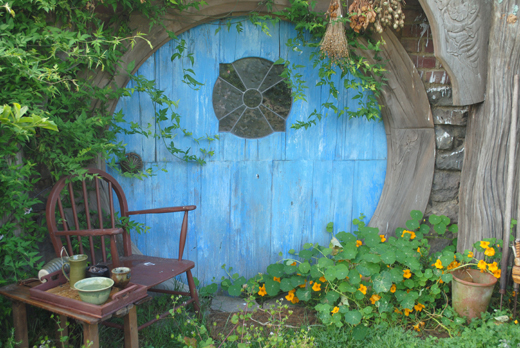 The Alexander sheep farm provided all three. Patriarch Ian Alexander was famously watching a rugby match when location scouts knocked on his door; Lucky for them it was halftime or he might have not have answered. He was told only that they wanted to scout for a movie so he sent them off on the land with a promise to close all gates to keep the sheep from running wild; He had rugby to watch.
The Alexander sheep farm provided all three. Patriarch Ian Alexander was famously watching a rugby match when location scouts knocked on his door; Lucky for them it was halftime or he might have not have answered. He was told only that they wanted to scout for a movie so he sent them off on the land with a promise to close all gates to keep the sheep from running wild; He had rugby to watch.
Six weeks later the production was back asking to use the farmland and after a period of figuring out what it was going to cost to interrupt the farm with built roads and massive logistical requirements, a deal was struck to turn part of the Alexander’s land into the mythical neighborhood of one Bilbo Baggins. The next day the army was on hand to prepare the farm for the motion picture trilogy and by that night, word reached the internet; Lips lossened by adult beverages were responsible, according to locals, and soon the media descended on a farm in a very rural area.
As part of my trip to NZ, I was invited to visit the set with some unique access to see just what film crews had been up to after recently getting the set perfect for The Hobbit. At my side was one of New Zealand’s most read authors, Ian Brodie, who put together the Lord of the Rings Locaton Guide Book and got us to the set a couple of hours before the first of many caravans full of visitors. He promotes The Hobbiton Movie Set and Farms tours and is also a skilled photographer who is in the region regularly taking photos that do great credit to the New Zealand landscape. (You can see his work right here and he happens to be a great guy too.)
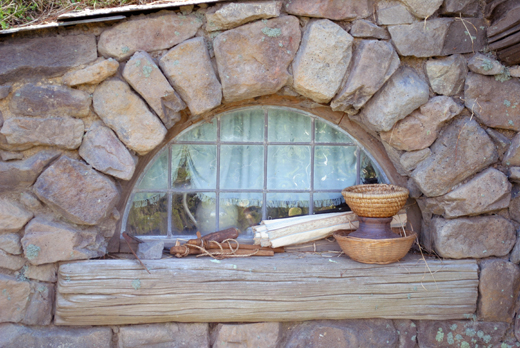 Stepping into the Hobbiton film set does genuinely create the illusion of stepping into a real yet fantastical place where it seems doors might open at any second and actual Hobbits might stride forward, pipes in place, looking for second breakfast. There are vivid but earthy tones on doors along with handles and windows and chimneys that are all recognizable to viewers of the LOTR films who remember grumpy hobbits disapproving of Gandalf, delighted ones watching his fireworks and all the rest with their enormous pigs and chickens and waxy ears.
Stepping into the Hobbiton film set does genuinely create the illusion of stepping into a real yet fantastical place where it seems doors might open at any second and actual Hobbits might stride forward, pipes in place, looking for second breakfast. There are vivid but earthy tones on doors along with handles and windows and chimneys that are all recognizable to viewers of the LOTR films who remember grumpy hobbits disapproving of Gandalf, delighted ones watching his fireworks and all the rest with their enormous pigs and chickens and waxy ears.
But heading in early with Brodie and then entering the set again as a part of a tour, what makes the place unique and special and beloved, is the emotional experience the environment creates. It is difficult to have invested hours and hours reading about Hobbiton in J.R.R. Tolkien’s works combined with a few shared screenings of Jackson’s films (and for some, many more screenings than a few) and not feel a stirring when walking the grassy paths in person.
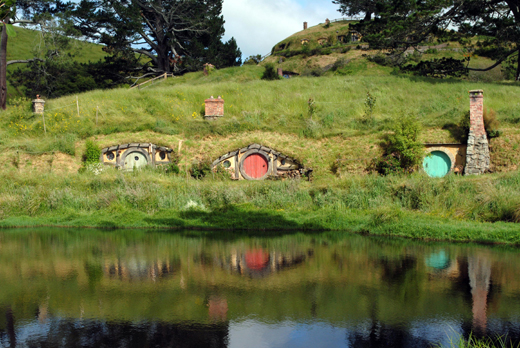 The part of a person that experiences art instantly recognizes the craftsmanship that made the hobbit facades happen. There are a lot of careful choices in details that enrich the experience from mailboxes to door knobs.
The part of a person that experiences art instantly recognizes the craftsmanship that made the hobbit facades happen. There are a lot of careful choices in details that enrich the experience from mailboxes to door knobs.
And the experience is much richer for the details. Hobbit holes come in two scales, providing the production a chance to shoot characters such as Gandalf in front of small holes, appropriate for hobbits, adding to his perceived height. (See a photo of me for reference). Around both sizes of rounded doors are all the movie props that inform the viewer, even on a sub-conscious level, about the person we want to believe lives inside. An axe or dried flowers or a broom or bottles in the window add significantly to the impression that the illusion is real.
Equally impressive are the greens works maintained by a team of gardeners, some of whom have been working there for years in preparation for The Hobbit. All parties involved are quick to sing the praises of Brian Massey as the head of the greens team. He is the mastermind who made concepts into reality but instead of working with paint and plaster, he uses living things.
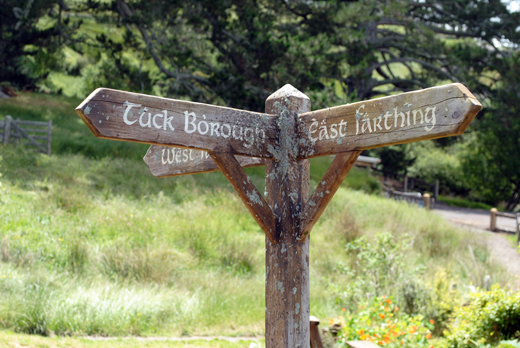 Onion bulbs and blooming flowers and drinking cups all add to the emotional and visual depth on display. In short, it’s what Hobbiton looks like on film but with all the details that never make it to the screen in a full surround environment with the scents and sounds that make it so much more authentic than a sound stage.
Onion bulbs and blooming flowers and drinking cups all add to the emotional and visual depth on display. In short, it’s what Hobbiton looks like on film but with all the details that never make it to the screen in a full surround environment with the scents and sounds that make it so much more authentic than a sound stage.
The obviously recognizable Baggins’ residence is here as is the movie-ending home of Samwise Gamgee. But of course, the all-important details go beyond the “hero” holes and all are now built not with a few weeks of shooting in mind but having a long-term attraction for those who want to feel like they are stepping into a small piece of Middle-earth.
Not on the tour but clearly visible across the lake is a structure thought to be the Green Dragon; A place that will perhaps offer visitors a chance to find refreshment without leaving Middle-earth.
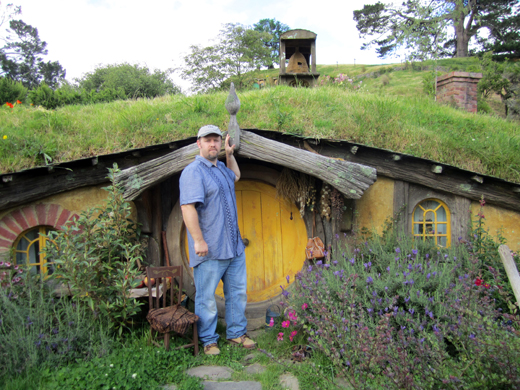
The day I visited, Russell was watching and directing the near completion of a souvenir shop that will support what is termed “The Shires Rest,” then serving as a café, a meeting spot for tours preparing to enter the farm or a place to relax. In our conversation, he stressed the need to consistently but gradually grow the services and offerings of his farm to tourists while retaining the appropriate experience. He hopes and believes the place will endure and add to the heritage of the Matamata region and New Zealand.
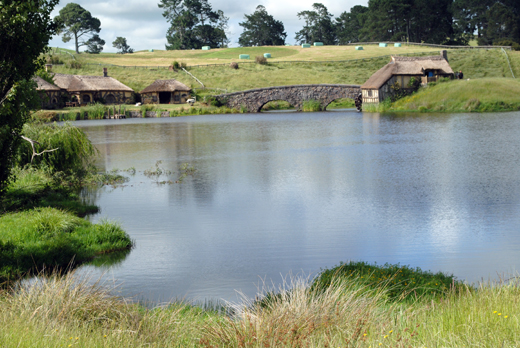 The town calls itself “Hobbiton” with a sign on its main business street and visitors can grab a shuttle there that delivers them to and from the farm. There is also parking for those who make their own way to the gateway of the film set, appropriately situated on, yes really, Buckland Road, a name that was around 100 years before a location scout ever turned up.
The town calls itself “Hobbiton” with a sign on its main business street and visitors can grab a shuttle there that delivers them to and from the farm. There is also parking for those who make their own way to the gateway of the film set, appropriately situated on, yes really, Buckland Road, a name that was around 100 years before a location scout ever turned up.
Tours can be booked and shuttles boarded from Rotorua and additional tourism packages are available at the Hobbiton website.


